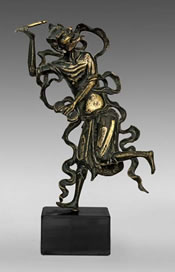
Great Star of the Literary God
Zhong Kui, K'uei Hsing, Kui Xing
Chief Star, Big Dipper Constellation, Point to the Major Luminary
December 14, 2007

K'uei Hsing (Kui Xing)
Lesser God of Scholars Taking Examinations
For many centuries, Chinese scholars provided offerings to and prayed for favors from a deity that was known to be supportive of an intellectual, literary, or scholarly lifestyle. One "Literary God" is Wen Chang [1], who is often pictured with his two supernatural subordinates: an ugly fellow named K'uei Hsing (Kui Xing) who assists his supplicants in passing examinations and in earning degrees and diplomas, and a second fellow named Chu Yi (Red Coat) who assists scholars in finding good jobs. Both, Wen Chang and K'uei Hsing [2] were thought to live in a mansion in the Big Dipper portion of the constellation Ursa Major. Another deity that is sometimes associated with scholars is the God of War, the patron saint of martial artists, Guan Di [5].
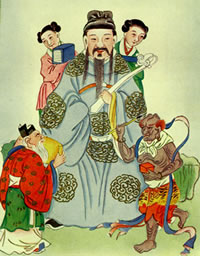
Wen Chang, The Literary God
In the lower left is Chu Yi (Red Coat), and in the lower right is K'uei Hsing (Kui
Xing).
One legend about K'uei Hsing (魁星 Kui Xing [2]) is that he was a brilliant student, an outstanding scholar, and received the highest score on the Imperial examinations, but had problems. If you scored the highest on the Imperial examinations, then you were awarded a golden rose. K'uei Hsing was, unfortunately, extremely ugly and a handicapped dwarf. One story says that the Emperor was so repulsed by K'uei Hsing that he dropped the golden rose and it broke into pieces, another story says the Emperor refused to give the golden rose award to the scholar. In either case, K'uei Hsing was, of course, extremely disappointed and became despondent. While traveling, it is said that he fell or jumped into the ocean or river from a boat. A sea dragon or one legged sea monster rescued him and then escorted Kui Xing up into the Heavens, where Kui Xing took up residence with Wen Chang in the Big Dipper part (asterism) of the Ursa Major Constellation. Their heavenly abode is in the square part of the Big Dipper.
Another character from Chinese mythology, Zhong Kui (鍾馗 [3]), was also an outstanding scholar, with a disfigured appearance, who was unfairly denied examination honors by the Emperor, who commits suicide, and who then again makes his appearance as a powerful vanquisher of ghosts and demons. He was a very popular figure in Chinese folklore, and many homes had some kind of picture of this supernatural protector of homes, and vanquisher of evil. He was a popular door guard or portal guard used to keep evil and malicious forces out of homes and buildings. As part of the Duanwu Festival (Dragon Boat Festival, Summer Solstice), part of the Daoist traditions, portraits of Zhong Kui were hung up in homes and buildings.
Mythological characters with similar backgrounds or with similar service functions for humans are often blended together. Some say that an ugly scholar named Chung K'uei who met a tragic demise was later venerated and given the the honorific title of 'Wen Chang.' Wen Chang and Kui Xing are sometimes spoken of as if they are a single entity. Sometimes, Zhong Kui is spoken of as a deity helping scholars taking examinations. The fact that K'uei Xing and Zhong Kui are portrayed in artworks in a similar fashion, as a ugly man standing on one leg and holding a sword or brush in an upraised hand, and the word Kui (星座) stands for "a one-legged monster," has led to a mixing of meanings.
K'uei Hsing (Kui Xing 魁星 [2]) is often represented in popular art as a very homely and deformed fellow, standing on one leg and holding the other leg up behind him, holding a writing brush above his head in his right hand, and holding an inkwell or measuring cup in his left hand. Zhong Kui 鍾馗 [3] is often represented as a fierce looking bearded man, standing on one leg and holding the other leg up with bent knee, with a sword raised in his right hand, and the other hand raised with pointed fingers.
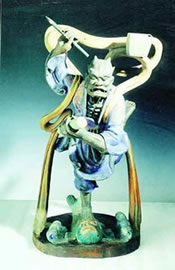
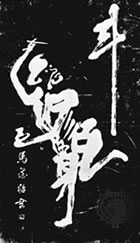

K'uei Hsing (Kui Xing) [2]
Lesser God of Scholars Taking Examinations
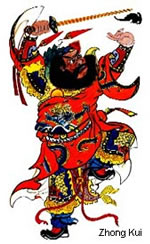
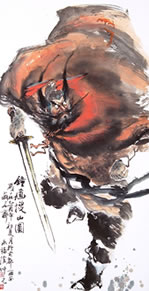
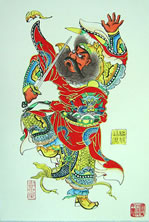
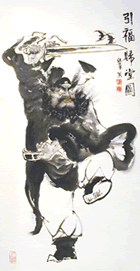
Zhong Kui [3]
Powerful Protector and Vanquisher of Ghosts and Demons
The word Kui or K'uei is pronounced Kui2. There are a number of words pronounced Kui2, but which have different Chinese ideographs. For examples, Kui2 夔 A One Legged Monster; Kui2 星座 The Name of a constellation; or Kui2 魁 Chief, head. Other Chinese words with similar sounds to Kui (Kui1) mean 'deficiency, deficit, set back, losses, to fall short of, to treat unfairly." The word Xing is pronounced, Xing1. Xing1 星 Star, satellite Xing1 zuo4 星座 Constellation. Shi 势 Shi4 implies a form, position, tendency, posture, terrain, situation, configuration.
Five of the seven stars in the Big Dipper minor constellation [4] are of second magnitude brightness, and one, Mizar, is a visual binary star. The constellation of Ursa Major, which includes the Big Dipper, is visible at all times in the night sky of the northern hemisphere, and the Big Dipper 魁星势 is used to locate or point towards Polaris, the North Star. Consequently, Kui Xing 魁星 is linked to bright stars, important stars, a major constellation and the Big Dipper and is called, in various sword forms: The Big Star, Chief (Kui Chief 魁) Star (Xing 星0, the Big Dipper Constellation, Indicate the Major Luminary, and the Great Star of the Big Dipper. Also, again, both K'uei Hsing (Kui Xing) and Wen Chang, as well as other mythological deities such as The Fates and Queen Marichi, are said to have their abode in the cup part of the Big Dipper.
There are a number of appearances of monsters with one leg, guardians standing on one leg, or creatures standing or kicking back one leg in Chinese myths and legends. Loosing (kui1 loss or deficit 亏) a leg due to a birth defect or accident would pose serious problems and setbacks for anyone. The unearned misfortune, like extreme ugliness or other physical deformities, would be seen as unfair, and associated with unnatural evil; or possibly as a sign that the person had special shamanic powers or other compensatory talents, e.g., scholar, musician, shaman-priest. On the negative side, Kui2 夔 a one-legged monster, an evil deity on one leg, a fierce guarding deity like Zhong Kui standing on one leg, a one legged mountain monster, or a one-legged Yecha are blended in with the meanings associated with K'uei Hsing (Kui Xing) and his unfortunate grotesque appearance.
In the Standard Taijiquan Sword (Jian) 32 Form we find movements called Chief Star Form or The Big Dipper (#2: Kui Xing Shi: 魁星势) and the Little Dipper (#4). In the Classical Yang Taijiquan Sword (Jian) 55 Form we find movements called the Chief Star or Big Dipper (#3) and the Little Star of the Big Dipper (#7). The Big Dipper or Chief Star was called "Great Star of the Literary God" (#3: Da Kui Xing) and Small Star of the Literary God (#7: Xiao Kui Xing) by Chen Weiming in his book "The Tai Chi Sword" (1928). In the Chen Taijiquan 49 sword form, there is a movement (#23) named "Zhong Kui Brandishes His Sword" which is very similar to Chief Star or Big Dipper, except that the left foot is in a toe stance more like the Little Star of the Dipper (Yang sword #7, 32 Sword #4). The shape of the Big Dipper or Drinking Gourd or Plough is suggestive of the posture: the long handle of the Big Dipper (standing on one leg), the upper part of the Big Dipper pointing to the Polestar (the pointing of the the writing brush or pen), the lower part of the Big Dipper (the left hand raised with finger pointing or holding something).
There are a number of named movements in Taijiquan sword forms that explicitly refer to stroke methods used in Chinese calligraphy and some are part of the 13 Sword Techniques, e.g., #8 Dian 点 dot, #7 Ti 提 upwards character stroke. A number of noted Taijiquan teachers have also been master calligraphers. Chen Weiming, a scholar and archivist, would also have had an affinity for literary attributions and legends and these subtly appear in his popular and influential 1928 book "Tai Chi Sword." Naming movements after popular heroes in folklore, the Taoist or Buddhist religions, or myths is one method for helping martial arts practitioners remember the movements, and sustaining Chinese culture and traditions.
In the Taijiquan sword form, the Great Star of the Literary God or Big Dipper or Chief Star is performed by holding the sword in the right hand above the head, extending the left hand and pointing upward with the sword fingers, and lifting the left knee in the air. The one leg is the ladle of the Big Dipper, and the hands form the sides of the cup (ladle, gourd) of the Big Dipper or Drinking Gourd; and the tip of the sword points to the Polestar or North Star. The Big Dipper or Chief Star posture is the most frequently depicted posture used to represent the Taijiquan Sword form.
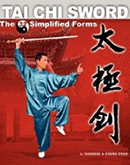
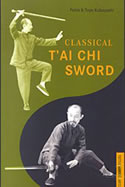


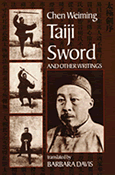
Depending upon the teacher of the form, the movement called the Great Star of the Literary God, Chief Star or Big Dipper, is referred to by various names in the 32 Sword or 55 Yang Sword:
Great Star of the Literary God (Da Kui
Xing) [CWM 3]
Big Chief Star (Da Kui Xing) [YJM 5]
Great Star of the Big Dipper [PTK 3]
Big Dipper (Kui Xing Shi) [YJ 4]
Major Star of the Big Dipper
[SMR]
Big Dipper
Major Polestar (Xiao Kuixing) [SM 4]
Indicate the Major Luminary
The Major Star of the Big Dipper
Standing on One Leg and Thrusting the
Sword
Thrust Backward Independently
Opposite Pierce with One-leg Stand
Big Dipper Constellation
The Evil Deity Standing on One Leg
The Big Dipper
[MPG
3]
Kui Xing Shi
(Ch.)
La Constellation De Grand Huit
(Fr.)
Die Wagen-Konstellation
(Gr.)
La Constelación Del Cucharón Grande (Sp.)
大魁星
: Big Chief Star : Da Kui Xing
魁星势
: Big Dipper, Kui Xing Shi
Depending upon the teacher of the form, the Little Dipper or Minor Star of the
Literary God is referred to by
various names in the 32 Sword or 55 Yang Sword:
Small Star of the Literary God (Xiao
Kui Xing) [CWM 7]
Little Chief Star [YJM 8]
Small Star of the Big Dipper [PTK 6]
Little Dipper [YJ 8]
Minor Star of the Dipper [SMR]
Minor Polestar [SM 7]
Minor Star of the Dipper
Indicate the Minor Luminary
Little Chief Star
Split Independently
Wheel Chop with One-Leg Stand
Sounding the Sea
Searching the Sea
Single Leg Stance Reaching Into the Sea
Stand on One Leg and Cut with Arm Swing
Techniques: Ya (Pressing or Pushing Down), and Chou (Cutting
Upward)
The Little Star of the Big Dipper [MPG 7]
Xiao Kui Xing
(Ch.)
Le Peu Tiennent le Premier
Rôle de la Constellation de Grand Huit
(Fr.)
Der Kleine Stern der
Wagen-Konstellation
(Gr.)
La Pequeña Estrella de la Constelación del Cucharón Grande (Sp.)
夜叉探海 :
小魁星 : Little Star of Dipper
The Little Dipper or Small Star of the Literary God has the sword pointing down rather than forward. The left sword hand touches the right wrist. The left leg is extended forward in a deep left empty stance, or the left leg is lifted.
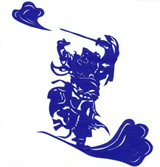
Research Notes
"In 1928, the first small book on the Taijiquan
double edged straight sword (Jian) form was published: The Taiji Sword.
It's author, Chen Weiming
陳微明 (real name: Chen Zengze 陳曾則) (1881-1958)
was a scholar, historian, and taijiquan instructor. Chen Weiming studied with
Sun Lu Tang, and with General Li Jing Lin (Fang Chen) (1885-1931), a Wudang
sword master. Chen Weiming was a senior student and close friend of the famous
Taijiquan Grand Master Yang Cheng Fu, and collaborated with Yang Cheng Fu when
publishing three taijiquan books."
- Classical Yang Taijiquan Sword 55 Form
Chinese martial artists, mostly illiterate, have always used names for movements in martial form that refer to real and mythical animals, characters from folktales and legends, famous martial artists and heroes, and key techniques.
Wen Chang
Wen-ch'ang, the Daoist God of Literature:
"Wen-ch'ang is the constellation of six stars near the Great Bear [The Bige
Dipper]. It is said that when these are bright. litearture flourishes.
Wen-ch'ang was above all venerated by those who neededhelp with the official
examinations for an official career. He is usally shown in the company of
K'uei-shing, responsible for issuing official testimonials, and Chu-i, the red
robed one, patron of those ill-prepared for official examinations. [Compare
modern Roman Catholic devotion to St. Joseph of Cupertino who is invoked for
unprepared examination candidates.]"
- The Encyclopedia of Eastern Philosophy and Religion, (
Boston: Shambala, 1986), p. 415
Wen Ti also called Wen
Ch'ang , or Wen Ch'ang Ti-Chün , Pinyin Wen Di, Wen
Chang , or Wen Chang Dijun the Chinese god of literature, whose
chief heavenly task, assigned by the Jade Emperor (Yü Huang), is to keep a log
of men of letters so that he can mete out rewards and punishments to each
according to his merit. He also maintains a register of the titles and honours
each writer has received.
- Encyclopedia Britannica
![]()
Kui Xing, K'uei Hsing
Kui Xing, in Chinese mythology, a brilliant but ugly dwarf who as the god of examinations became the deity of scholars who took imperial examinations.
"K'uei Hsing, whose name before deification was Chung K'uei, is said to have passed his own examination with remarkable success but was denied the usual honours when the emperor beheld his ugly features. Brokenhearted, K'uei attempted…
"In his Myths and Legends of
China, E.T.C. Werner mentions a K'uei or Chung K'uei who
"ascended to heaven and became arbiter of the destinies of men of letters.
His abode was said to be the star K'uei, a name given by the Chinese to
the sixteen stars of the 'mansion' of Andromeda or Pisces. The
scholars quite soon began to worship K'uei as the God of Literature, and
to represent it on a column in the temples. Then sacrifices were offered
to it. This star or constellation was regarded as a palace of the god."
Werner also notes that the Chinese character K'uei
denoted a disembodied spirit, a ghost, or (as a plural) demons.
Consistent with this author"s account of Chung K'uei, Raymond
Deloy Jameson tells us (in Leach) that Kuei Hsing was "an ugly dwarf associated
along with Chu Yi, with Wen Ch'ang, the Chinese God of Literature.
The legend is that he was a brilliant student and won the first prize in the
Imperial examinations. But because of his ugliness the emperor refused to
grant him the golden rose that should have been his reward. Kuei Hsing
threw himself into the ocean, was rescued by a sea monster (a dragon), and
ascended into Heaven where he took up his residence on a star kuei hsing,
now construed as being located in the the square part of the constellation Ursa
Major. He is popularly represented holding a writing brush in his right
hand, a bushel measure in his left, and kicking up one leg behind him.
This twisted position is thought to suggest the Chinese ideograph kuei.
Wen Chang also has his abode in the big square mansion in Ursa Major."
The Pro/Am Book of Music and Mythology. By Thomas P. Lewis. p. 1015
"Early in the Sword Form, we meet two star postures, Da Kui Xing and Xiao Kui
Xing. For want of precise equivalents, these can be translated as the Big and
Little Dipper. It turns out that “Kui Xing” can be seen as a reference to the
four stars that form the bowl of the Big Dipper and particularly to the star at
its tip. “Kui Xing” could also be understood literally to mean the “Chief Star.”
This “Chief Star” is associated with the God of Literature, who is often
depicted as standing on one leg, waiving a brush over his head with one hand and
holding an inkwell before his body with the other. The reason he stands on one
leg is unclear, but it could be because his persona has merged with that of a
legendary one-legged mountain monster of old. This monster’s name is spelled
with a different character, but has the same pronunciation, “kui.” In this
meaning, the sounds of the name “Kui Xing” would evoke the sense of the “the
Star of the One-Legged Monster.”
One tale about Kui Xing is as follows. One year, a scholar came in first during
the civil service exams that were the road to fame, fortune, and respect for the
elite in traditional China’s imperial society. Unfortunately, this scholar was
so ugly that the emperor shied away and failed to accord him the customary
honors. Humiliated, the scholar tried to drown himself in a river, but was saved
by a sea beast that carried him up into the heavens. There, he became the god of
the star at the tip of the big dipper and the patron god of literature and
scholarship.
The next time you perform these postures, make sure to copy Kui Xing’s pose and
show enough spirit to scare off an emperor."
- Audi Peal,
The Sword Form: Flying Through Myth and Legend
From The Journal of the International Yang Style Tai Chi
Chuan Association, No. 15, Winter 2005.
"A Chinese legend tells the story of the four stars which make up the bowl of the Big Dipper. These stars were the home of the "fates," the Queen Marichi and all her attendants and the god of literature. Clearly, it was a crowded home!
The story begins one time when a young lad by the name of K'uei who was a literary student known for his great learning and brilliant wit. Unfortunately, K'uei was also rather ugly, so ugly in fact, that not even the most kindhearted person could help but shudder when their eyes fell upon him. So although K'uei was smarter than any before him, and witty, he had no friends.
At this time, it was customary for the emperor to present a golden rose to the winning candidate at the metropolitan examinations. As fate would have it, K'uei had won this honor. K'uei was very proud when he approached the throne but alas, when the emperor, even though he had been forewarned, laid his eyes upon the ugly K'uei, he dropped the rose and there it lay shattered.
Poor K'uei was in disgrace, and so, brokenhearted and finding life intolerable, he threw himself into the sea. As K'uei passed under the cool, calmness of the waves he was aware that under his feet had appeared a monster. The creature was one of those strange beasts who inhabit the depths of the sea, and he was lifting K'uei back up towards the surface.
The monster rose out of the waves with K'uei safely on his back and continued
to mount higher and higher in the air, until at last he had reached the very sky
itself. There, enthroned among the stars of the Bear, K'uei now watches over the
literary affairs of the world and is the patron saint of all scholars."
-
Ursa
Major Legends
![]()
Guan Di
"Guan Yu, also known as Guan Di,
is the God of War in Chinese culture. Born around 120AD, he is a hero recognized
for his patriotism and courage, as well as his skill in tactical warfare. Guan
Yu was killed in 219 AD by his adversaries (led by the powerful emperor, Sun
Quan), and was canonized by the Song Emperor in 1120 AD. In 1594, Guan Yu was
deemed a god. To this day, his birthday is celebrated every year, which takes
place on the thirteenth day of the fifth lunar month.
Guan Yu is also recognized as Sangharama Bodhisattva, an
important god in the Buddhism practiced in China. He is also the God of Police
Officers.
Along with his two blood-brothers, Liu Bei (a warlord) and
Zhang Fei, Guan Yu fought against the evil forces of the Eastern Han Dynasty.
He remained loyal to them until his death.
Guan Yu, and in fact his brothers as well, are vital figures
in the Chinese martial arts. He represents courage, bravery, and strength, all
important qualities for practitioners to aspire. Most clubs have an altar, on
which a statuette or picture of Guan Yu (and sometimes his brothers) is placed.
Guan Yu is characterized as a proud, red-faced warrior with a long black beard,
clad in heavy armour. He may be standing or can be on horseback, holding the
traditional Chinese pole weapon he invented, the guan dao."
-
Guan Yu
Awakening the World Scripture. By Lord Guan Yu.
Guan Yu is a Daoist God of war and martial arts. His story is told in the Romance Of The Three Kingdoms. He was a vendor of soya bean curd, who later defended the poor against corrupt officials, and was a skilled fighter. Guan-Yu (Guan Yn Chang, Guan Gog, Guan Di, Chang Zeng, Chang Yun) is associated with Liu-Bei and Zhang-Fei, and one of the Three Brothers of the Peach Orchard. He is really a peace loving deity, but a brave and skilled warrior for the forces of good and justice. Guan Yu is also a patron saint for peace officers, revered by Buddhists as a defender of the faith, and also worshipped as a "God of Literature." Source1 Source2
"The Taoist god is Guandi, Emperor Guan, who
remains an immensely popular deity in China today. A martial figure, his
military and spiritual protection was sought by individuals and the state. As
Stephen Little has noted, Guandi (Emperor Guan) evolved from a third century
Chinese military hero, Guan Yu, who underwent hagiographic transformation during
the Song dynasty (960-1279) and became a guardian of the Taoist faith as Marshal
Guan. During the late Ming dynasty (1368-1644), he became known as God of War,
Emperor Guan (Guandi)."
- Rossi and
Rossi
![]()
Big Dipper
"[Lat.,=the great bear; the little bear], two conspicuous northern
constellations.
Known to many peoples from ancient times, these constellations have had various
names; the configuration of the seven brightest stars has been called the Bear,
Septentriones (the seven plowing oxen), the Plow, Charles's Wain, and the Wagon.
Ursa Minor was once known as Cynosura (from the Greek for "dog's tail"). In the
United States part of Ursa Major is called the Big Dipper (or the Drinking
Gourd) and part of Ursa Minor, the Little Dipper. Four of the seven bright stars
in the Big Dipper form the bowl and three the handle; five of these stars are of
second magnitude. The middle star in the handle of the Big Dipper is Mizar (Zeta
Ursae Majoris). A fainter star, Alcor, which appears to be near Mizar, was
observed from ancient times. These two stars are sometimes called a double star,
but since they do not revolve around a common center of gravity they are not
true doubles. Mizar itself is, however, a visual
binary star
and was the first to be recognized as such—by G. B. Riccioli in 1650. It was
also the first spectroscopic binary to be discovered; this observation resulted
from studies of the spectrum of the brighter component of Mizar, which revealed
it as a binary consisting of a pair of stars of almost equal brightness. The two
end stars in the bowl of the Big Dipper are known as the Pointers. A line
extending through them to about five times the distance between them leads to
the polestar (Polaris,
or the North Star). Polaris is at the extreme end of the Little Dipper.
Including Polaris there are three stars in the handle of the Little Dipper and
four forming the bowl. The handles of the two Dippers extend in opposite
directions, and when one bowl is upright the other is inverted. Ursa Major
reaches its highest point in the evening sky in April and Ursa Minor its highest
point in June. However, for observers in the middle and northern latitudes of
the Northern Hemisphere both constellations are circumpolar and thus are visible
throughout the year."
-
Ursa Major - Questia
"In oracle inscriptions as well as historical texts, the wu [shamans]
have been described as deformed or as hunchbacks. If a certain deformity
was considered to be the sign of a possible religious talent, other disabilities
have been regarded widely as the sign of possible compensatory gifts. The
mythical K'uei [夔 kui2], the patron of musicians, is described as a one-legged
monster who taught men how to play on stones to bring down the gods and
spirits."
- Julia Ching,
Mysticism and Kingship in China: The Heart of Chinese Wisdom, p. 17
![]()
Zhong Kui
"Zhong Kui (鍾馗 pinyin: Zhǒng Kuí Shōki in Japanese) is a figure of Chinese mythology. Traditionally regarded as a vanquisher of ghosts and evil beings, and reputedly able to command 80,000 demons, his image is often painted on household gates as a guardian spirit, as well as in places of business where high-value goods are involved.
According to folklore, Zhong Kui travelled with Du Ping (杜平), a friend from his hometown, to take part in the imperial examinations at the capital. Though Zhong achieved top honours in the exams, his title of "zhuangyuan" was stripped by the emperor because of his disfigured appearance. In anger, Zhong Kui committed suicide upon the palace steps by hurling himself against the palace gate until his head was broken. Du Ping buried him. After Zhong became king of ghosts in Hell, he returned to his hometown on the Chinese New Year's Eve. To repay Du Ping's kindness, Zhong Kui gave his younger sister in marriage to Du.
Zhong Kui's popularity in folklore can be traced to the reign of
Emperor Xuanzong of Tang China (712
to 756). According to
Song
Dynasty sources, once the Emperor Xuanzong was gravely ill. He had a dream
in which he saw two ghosts. The smaller of the ghosts stole a purse from
imperial consort
Yang
Guifei and a flute belonging to the emperor. The bigger ghost, wearing the
hat of an official, captured the smaller ghost, tore out his eye and ate it. The
bigger ghost then introduced himself as Zhong Kui. He said that he had sworn to
rid the empire of evil.
When the emperor awoke, he had recovered from his illness. So he commissioned
the court painter Wu Daozi (吴道子) to produce an image of Zhong Kui to show to the
officials. This was highly influential to later representations of Zhong."
- Zhong Kui - Wikipedia
"The Duanwu festival is set on the 5th of the
5th month of the lunar calendar. The ancients arranged numbers according to the
Five Agents and Five is the middle number. The 5th of the 5th month, containing
a double five or a double middle number, is also called the Heavenly Middle
Festival
2. In the Twelve Celestial Trunks indicating time, the Wu hour is
the middle of day; and so Wu represents midday. Thus the festival is called
Right Wu or Double Wu. In ancient conceptions, the 5th of the 5th month is an
inauspicious day. Babies born on this day can't grow to adulthood; otherwise,
they will be harmful to their parents. Therefore, people had to find ways to
dispel their misfortunes, and thus formed the Duanwu festival with such
activities as dragon boat competitions. Some think the dragon boat competition
commemorates the great patriotic poet Qu Yuan. In fact, it is one of the Duanwu
activities to dispel the vices of the time. Some scholars such as Wen Yiduo
think it originated from the totemic cult of the ancient Yue people of the
south. In the Han dynasty at the latest, the vice-dispelling custom on Duanwu
had come into form. Daoism, after its formation, developed its special talent in
dispelling evil and deeply penetrated Duanwu customs. The important items are as
follows: Celestial Master Talismans
3, Realgar Wine
4, and Hanging up Zhong Kui's portrait
5."
-
Hanging Up Zhong Kui's Portrait
![]()
Tai Chi Simplified Standard 32 Sword Form. By Michael P. Garofalo. This popular webpage includes a comprehensive bibliography, scores of links to webpages; an extensive listing of the names and name variations for each movement in English, Chinese, French, German, and Spanish; a detailed analysis of each posture and movement sequence with explanations and numbered illustrations and detailed instructions; selected quotations; comments on 20 Taijiquan sword techniques; a comprehensive media bibliography; a chart of performance times; and, a comparison of the 32 and 55 sword forms in the Yang style. This is the standard, simplified, orthodox, 1957, 32 Taiji Sword Form, in the Yang Style of Taijiquan. This is the standard, simplified, orthodox, 1957, 32 Taiji Sword Form, in the Yang Style of Taijiquan. © Michael P. Garofalo, Valley Spirit Taijiquan, Green Way Research, Red Bluff, California, January 2008. 245Kb+.
”Classical
Tai Chi Chuan Sword, Taijiquan Jian 55 in the Yang Style: Comparison of Names
or Descriptions for the 55 Movements.” Green Way Research, Red Bluff, California, January 2008.
By Michael P. Garofalo. This document includes a detailed listing of the
names or brief descriptions of the 55 movements of the Classical Taijiquan Straight Sword
Form in the Yang Style of Taijiquan. This document includes names or brief descriptions
for each movement in English, Romanized Chinese (Pinyin and/or Wade Giles),
Chinese characters, Spanish, French, and German. The document
includes source citations and a bibliography. In PDF format, print only,
267Kb,
34 pages:
Webpage:
http://www.egreenway.com/taichichuan/Classical Taijiquan Yang Sword Form 55 List
Detailed.pdf
Sword - T'ai Chi
Ch'uan, 32 Form, Yang Style, Taijiquan Jian. By Michael P. Garofalo. This popular webpage includes a comprehensive
bibliography, scores of links to webpages, an extensive listing of the names and
name variations for each movement (English and Chinese), a detailed analysis of
each posture and movement sequence with explanations and numbered illustrations,
instructions, selected
quotations, a comprehensive media bibliography, and a comparison of the 32 and
55 sword forms in the Yang style.
© Green Way Research, Red Bluff, California,
January 2008.
HTML Version:
http://www.egreenway.com/taichichuan/sword32.htm 165Kb
PDF
Version.
http://www.egreenway.com/taichichuan/sword32MPGFull.pdf 1.07MB,
63 pages, PDF Print Only Version
Yang Style, Standard Orthodox 32 Sword Form, List of
32 Movements, Valley Spirit Taijiquan List:
http://www.egreenway.com/taichichuan/32SwordFulla.pdf
15Kb, 1 page, PDF Print Only Version
Yang Style
Sword Form, Classical Tai Chi
Sword, List of Movements, 55 Movements, Valley Spirit Taijiquan List:
http://www.egreenway.com/taichichuan/sword55.pdf 55Kb, 25
pages, PDF Print Only Version
Green Way Research:
http://www.egreenway.com/index.htm